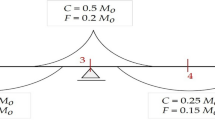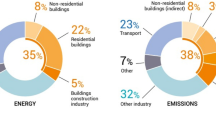Abstract
Slab formwork accounts for about 30–40% of the total project cost. Hence, it is one of the most critical concerns for design engineers in introspecting various qualitative and quantitative aspects of a construction project, including speed, cost, and work safety. In this paper, an optimum combination of the level of shore and level of reshore by considering different storey buildings has been identified using a population-based technique, SOMGA. An investigation has been carried out with four different storey buildings, i.e., 05, 20, 40, 50 stories for two concrete grades combined with varying construction days. The arrangement of loads on interconnected slabs during the development cycle is as indicated in ACI-347.2R-05. The validation of the optimized results obtained is done by analytical calculation as per ACI. Based on the results, it is concluded that minimum cost is achieved when a combination of 1 level of shore with 1 level of reshore is used to construct multi-storey buildings.
Access this chapter
Tax calculation will be finalised at checkout
Purchases are for personal use only
Similar content being viewed by others
References
ACI 209R-82, Prediction of Creep, Shrinkage and Temperature effects in Concrete Structures, Reported by ACI Committee 209
ACI 347–2R:2005, Guide for Shoring/Reshoring of Concrete Multi-storey Buildings, Reported by ACI Committee 347
AL-Tabtabai H, Alex AP, James R (1999) Slab formwork design using genetic algorithm. Durab Build Mater Compon 8:2407–2418
Calderon PA, Alvarado YA, Adam JM (2011) A new simplified procedure to estimate loads on slabs and shoring during the construction of multi-storey building. Eng Struct 33(5):1565–1575
Deep K, Dipti (2008) A self organizing migrating genetic algorithm for constrained optimization. Appl Math Comput, Elsevier 198(1):237–250
Dongping F, Haifeng XI, Xiaoming W, Chuanmin Z, Tingsheng Z (2009) Load distribution assessment of reinforced concrete buildings during construction with structural characteristic parameter approach. Tsinghua Sci Technol 14(6):746–755
Galeb AC, Zainab FA (2011) Optimum design of reinforced concrete waffle slabs. Int J Civ Struct Eng 1(4):862–880
Hanna SA, Ahmed BS (1995) Design optimization of slab formwork. J Const Eng Manag 121(2):215–221
Hyun C, Jin C, Shen Z, Kim H (2018) Automated optimization of form work design through spatial analysis in building information modeling. Autom Constr 95:193–205
Kamarthi SV, Sanvido VE, Kumara SRT (1992) Neuroform- neural network systems for vertical formwork selection. J Comput Civ Eng 6(2):178–199
Mosalla K, Wai-Fah C (1990) Design consideration for formwork in multistorey buildings. Eng Struct 12(3):163–172
Paul HS (1984) Charts aid in design of horizontal formwork. The Aberdeen Group, #C840648
Sahab MG, Toropov VV, Gandomi AH (2017) Optimum design of composite concrete floors using a hybrid genetic algorithm. Handbook of Neural Computation, Academic Press, Chapter 31:581–589
Singh D, Agrawal S (2016) Self organizing migrating algorithm with quadratic interpolation for solving large scale global optimization problems. Applied Soft Computing 38:1040–1048
Singh H, Rai HS, Singh J (2014) Discrete optimisation of one way slab using genetic algorithm. Int J Eng Bus Enterp Appl 9(2):116121
Author information
Authors and Affiliations
Corresponding author
Editor information
Editors and Affiliations
Rights and permissions
Copyright information
© 2021 The Author(s), under exclusive license to Springer Nature Singapore Pte Ltd.
About this paper
Cite this paper
Pal, S., Singh, D., Vidyarthi, P. (2021). Shoring-Based Formwork Optimization Using SOMGA for Multi-Storey Buildings. In: Singh, D., Awasthi, A.K., Zelinka, I., Deep, K. (eds) Proceedings of International Conference on Scientific and Natural Computing. Algorithms for Intelligent Systems. Springer, Singapore. https://doi.org/10.1007/978-981-16-1528-3_10
Download citation
DOI: https://doi.org/10.1007/978-981-16-1528-3_10
Published:
Publisher Name: Springer, Singapore
Print ISBN: 978-981-16-1527-6
Online ISBN: 978-981-16-1528-3
eBook Packages: Intelligent Technologies and RoboticsIntelligent Technologies and Robotics (R0)




